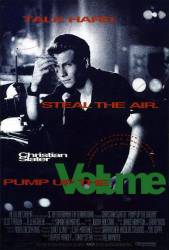Revealing mistake: Near the middle of the movie Samantha Mathis is walking across the high school campus. The name of the high school in the movie is "Hubert Humphrey High School, " but behind her, above the library door, a sign says "Saugus High School Library". Shows better in 4.3 aspect. (00:31:45)
Audio problem: Around half an hour into the film, some kids are listening to a tape of the radio show and a teacher takes the tape out because he doesn't like the content. As he takes the tape out, the audio ends right after the tape door opens, when it should have ended a little sooner, if it was actually coming from the tape player. (00:32:35)
Audio problem: When Nora is trying to tell Mark that it wasn't his fault that the boy committed suicide, her lips aren't in sync with what she is saying. (00:38:00)
Continuity mistake: When Paige is shown brushing her hair in front of the mirror, there is no background shown in the mirror behind her; it's completely black. We see this a few times while she's sitting at the dressing table, but then when she gets up to gather her things and take them to the kitchen, we see the room reflected normally. (00:43:25 - 00:44:30)
Continuity mistake: When Mazzilli is talking to the reporter in front of the school, he lights smoking firecrackers and throws them behind him. When we see him light the first one, it is at least three or four inches long when we see it in his hand, but much shorter an instant later when it hits the ground. This happens again with the next one too, but this time it's shorter when we first see it and slightly longer when it hits the ground. (00:54:25)
Factual error: Upon finding the cordless phone's base in the shed outside Mark's neighbor's house, the cop says, "There's the transmitter, which means the receiver could be in any house within 1,000 yards of here." I noticed no amplifier or anything to soup up the transmitter, and I know of no store-bought cordless phone with a range even remotely close to 1,000 yards. (01:09:05)
Continuity mistake: The FCC commissioner's limousine window goes up and down in between shots. (01:26:25 - 01:27:55)
Continuity mistake: When the teachers play the confiscated tapes of Harry, it's Christian Slater's voice, not the disguised voice you hear on the students' radios.
Factual error: When Christian Slater is talking on the phone in one scene, it is clear it is a cordless phone. When he slams it down, however, it makes that "ding" sound like older phones that really have a bell in them.
Continuity mistake: The entire 'typical American High School' wears the same clothes two days in a row, as a result of one day in the script which was divided into two days during the editing process.
Continuity mistake: When the guy in suspenders sneaks a cassette tape of Harry's show into the boombox, at the place where the students are dancing, the recording of Harry busting Deever is a completely different performance. You can tell because the word "Why" (from "W-w-why is that, Mr. Deever?") is much lower in pitch.
Audio problem: Throughout the final sequence, when Harry and Nora are in the jeep and being chased by the police cars onto the field by the gym, many of the words Harry says are out of sync with his mouth.
Audio problem: Just about every time someone starts or stops a cassette tape, we can see that they're either faking it or pressing the wrong button. In one shot, the 'Pause' button is down both before and after the actor presses 'Play,' which would of course mean that the tape shouldn't play at all.
Audio problem: When the reporter is filming the punk lighting smoke bombs in front of the school, he is encouraging his camera man to film the punk. His mouth doesn't match what he's saying briefly.
Audio problem: Near the end when Mark is shouting for the kids to start their own stations, in the wide shot the audio doesn't match up that well with what he's saying.






Answer: The first time I watched the movie, I kept thinking that Mark's parents were going to hear him and catch "Harry" in the act. When the girl was with Mark, Mark's parents pounded on the outside door; when Mark opened the door, his parents said they thought they heard him talking to someone. So, from outside the garage door, someone might be able to hear muffled voices but not the actual words. Why his parents cannot hear him in the basement when they are indoors lies in the props/scenery plus some inference. The numerous objects in the room (tapes, CDs, albums, guitar, drums, bongo drums, recording instruments, amps, etc.) indicate that Mark is into music - loud music - and electronics. He apparently was given garage/utility storage space to turn into essentially a studio for himself and a place to play his drums and music without disturbing his parents. The space has been sound-proofed - thick concrete walls, insulation, and cloth wall hangings to deaden the sound.
KeyZOid